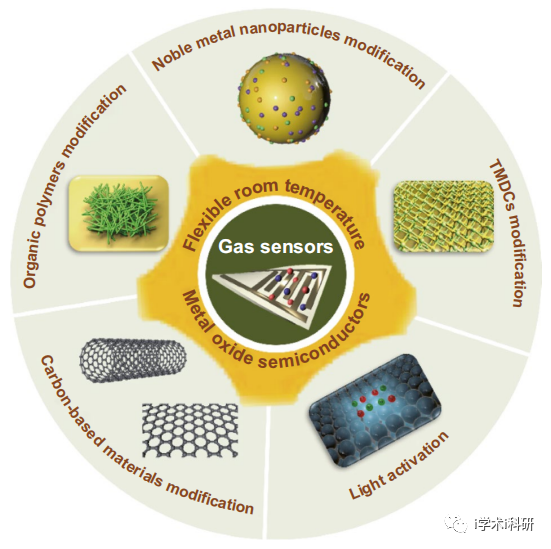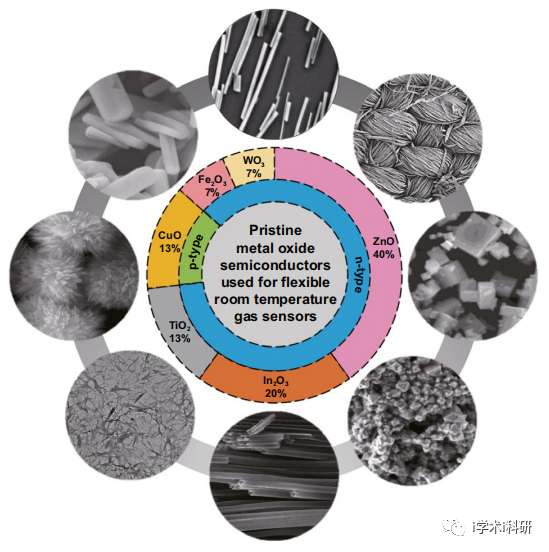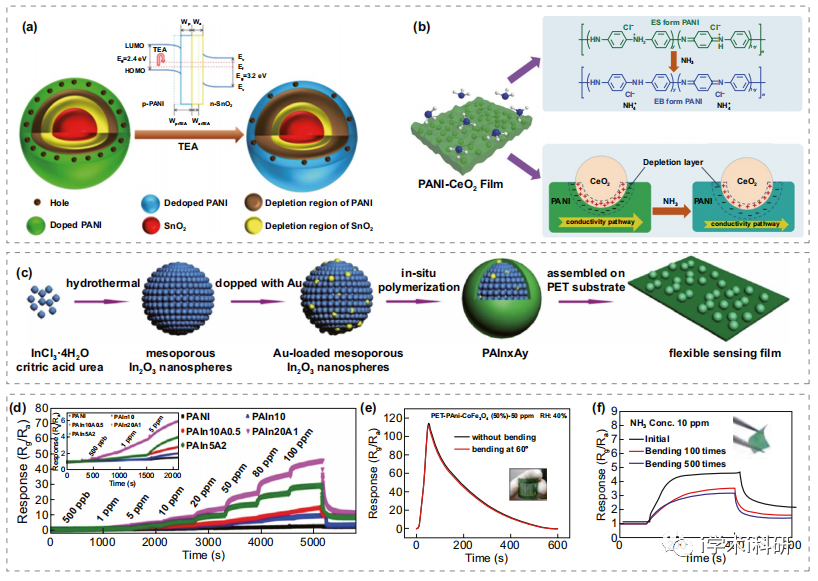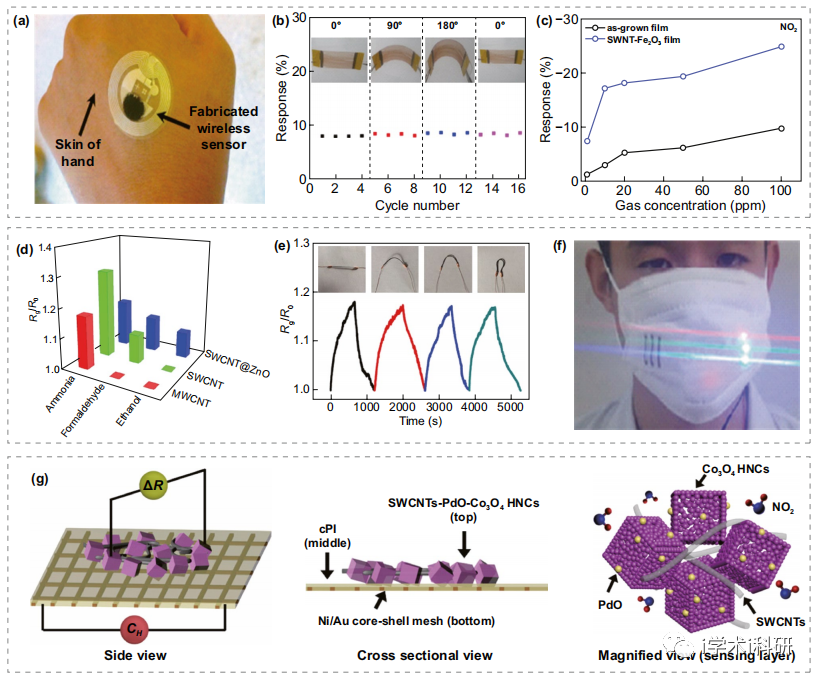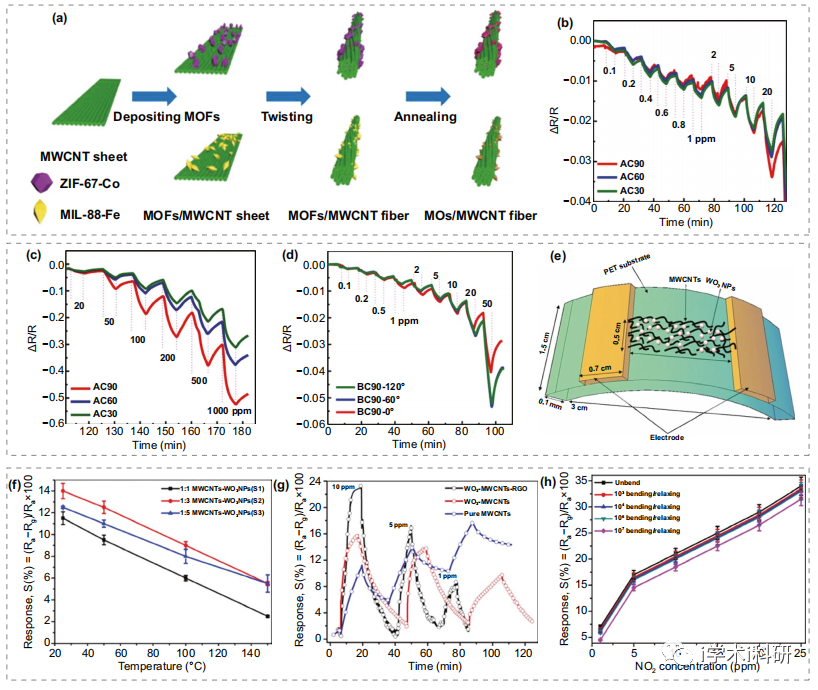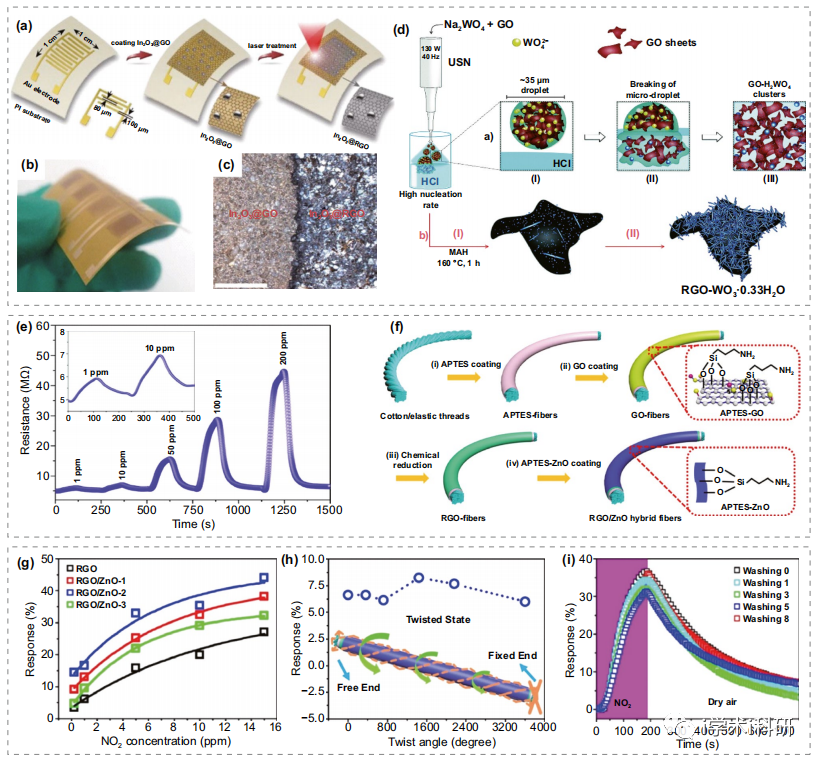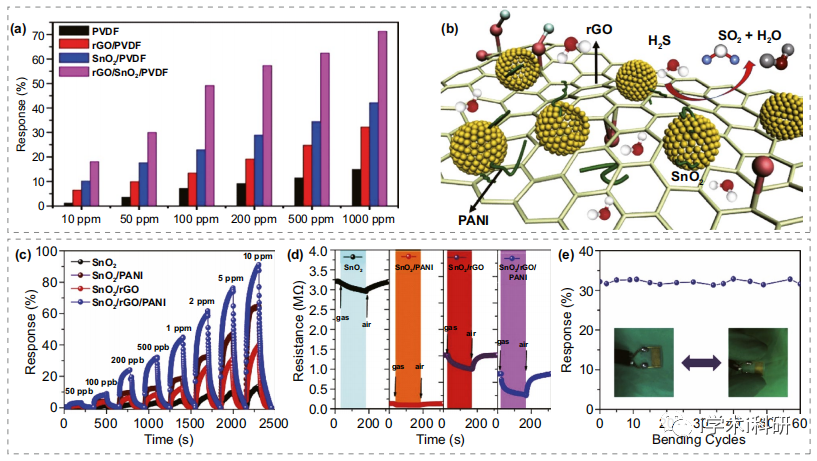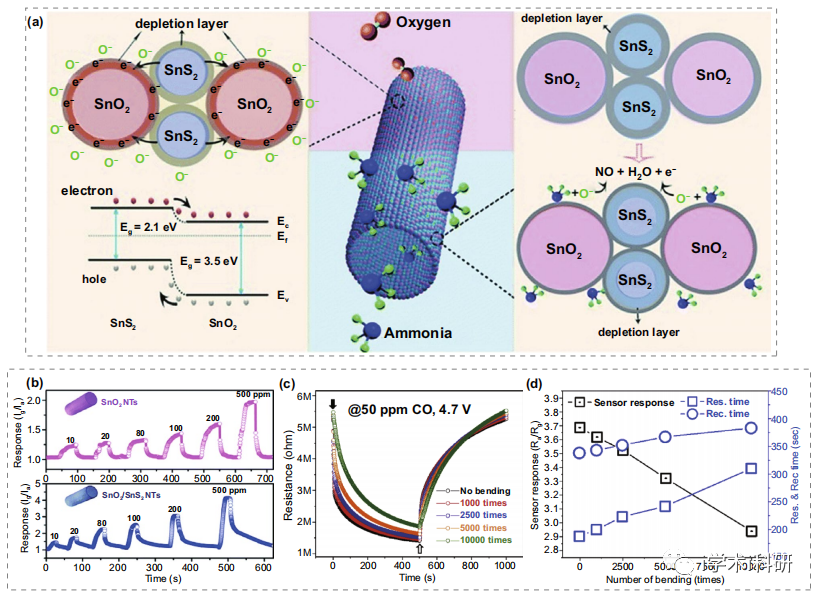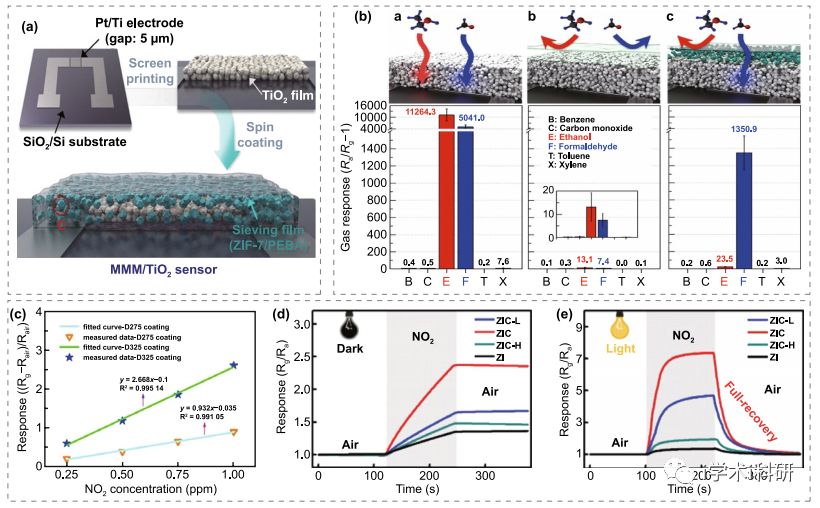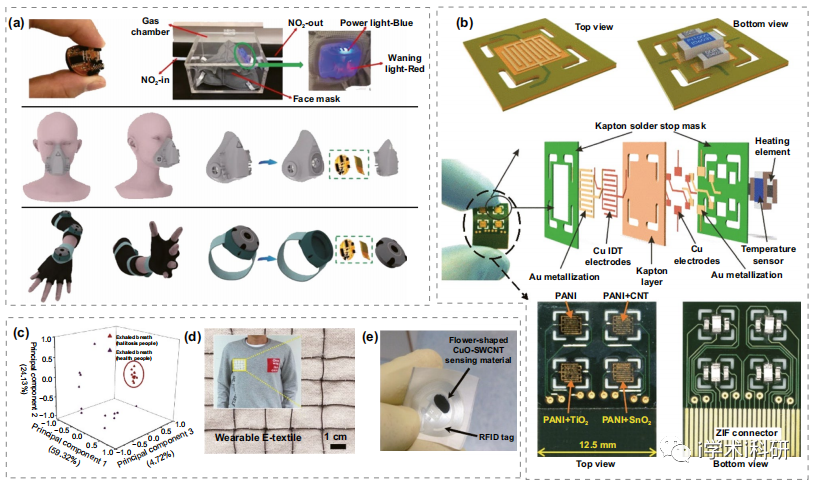随着物联网的快速发展,人们对便携式气体传感器有很大的需求。金属氧化物半导体(MOS)是最传统和研究最深入的气体传感材料之一,并已被广泛用于制备各种商业气体传感器。然而,它受到高工作温度的限制。目前研究工作的方向是制造高性能的柔性室温(FRT) 气体传感器,它能有效地简化基于MOS的传感器的结构,降低功耗,并扩大便携式设备的应用。
在过去的十年中,物联网(IoTs), 即连接不同传感器和执行器的网络工程,引起了巨大的关注。传统的电子传感器正逐渐从笨重的固态设备转变为便携式、高性能和多功能的设备。柔性电子器件的快速发展使其在物联网的广泛应用中发挥了重要作用,成为可穿戴设备的理想平台。近年来,柔性可穿戴设备已被用作笨重的分析仪器的有吸引力的替代品,并应用于对身体运动、血液温度、血糖、心率以及脑电图、心电图和肌电图等电生理活动进行连续生理监测。最近,metaverse 已经成为一个热点问题。Metaverses 是感官丰富的虚拟世界,人们在其中作为良性的化身相互接触,没有任何物理限制。集成了各种传感器的可穿戴设备,可以进行连续的生理监测和与软件代理的实时互动,对metaverse的快速发展具有至关重要的意义。随着物联网的快速发展,人们对便携式气体传感器有很大的需求。金属氧化物半导体(MOS)是最传统和研究最深入的气体传感材料之一,并已被广泛用于制备各种商业气体传感器。然而,它受到高工作温度的限制。目前研究工作的方向是制造高性能的柔性室温(FRT) 气体传感器,它能有效地简化基于MOS的传感器的结构,降低功耗,并扩大便携式设备的应用。研究成果
复旦大学卢红亮教授团队基于此发表关于金属氧化物半导体的柔性室温气体传感器的综述,主要介绍了基于MOS的FRT气体传感器在传感机制、性能、柔性特征和应用方面的最新研究进展。全面总结和讨论了五种基于MOS的FRT气体传感器,包括原始MOS、贵金属纳米颗粒改性MOS、有机聚合物改性MOS、碳基材料(碳纳米管和石墨烯衍生物)改性MOS,以及二维过渡金属二氯化物材料改性MOS。进一步讨论 了光照对改善气体感应性能的影响。此外,还讨论了FRT气体传感器的应用和未来前景。相关报道以“Recent Progress on Flexible Room‑Temperature Gas Sensors Based on Metal Oxide Semiconductor”为题发表在Nano-Micro Letters期刊上。1. 全面回顾了基于金属氧化物半导体(MOS)的柔性室温(FRT) 气体传感器的最新进展。2. 对基于原始MOS和用贵金属纳米颗粒、有机聚合物、碳基材料和过渡金属二氯化物材料改性的MOS的FRT气体传感器进行了细致的审查。3. 介绍了MOS化学电阻式气体传感器的气体传感机制,并提出了FRT气体传感器的应用、未来前景和挑战。Fig. 1 The strategies to achieve high-performance FRT MOS-based chemiresistive gas sensorsFig. 2 Schematic diagram of various pristine metal oxide semiconductor used for flexible room-temperature gas sensors introduced in this chapterFig. 3 a Cross-sectional view of the Pd-ZnO nanorods/PI/PET sensor after 1000 times bending/relaxing test. b The response, reliability test of Pd-ZnO nanorods/PI/PET sensor. c The selectivity of Pd–Ga-ZnO nanorods/PI sensor for various Ga-assisted seed layers conditions at 1000 ppm H2. d The optical image of Ag-ZnO nanorods/PI sensor. e Schematic illustration of the fabrication process of Pt-SrGe4O9 nanotubes. f Schematic illustration of the fabrication process of PANI/Rh/SnO2. g Response of PANI/Rh/SnO2 sensors to 50 ppm NH3 at RT under bending test.Fig. 4 Schematic illustrations of the sensing mechanism of a PANI/SnO2 and b PANI-CeO2 for enhanced gas sensing performance. c The process fow for preparation of Au-In2O3@PANI sensors. d Transient response of the Au–In2O3@PANI sensors to 0.5–100 ppm NH3 at RT. e Response of PANI-CoFe2O4 with a bending angle of 60° at 50 ppm of NH3. f Response of PANI @ porous nanospheres SnO2/Zn2SnO4 after 100 and 500 cycles of bending/relaxing test.Fig. 5 a The optical image of manufactured wireless RFID sensor. b Response of Fe2O3-SWCNTs sensor under large-degree deformation. c Response of SWCNTs and Fe2O3-SWCNTs sensor towards NO2 (1, 10, 20, 50, and 100 ppm). d Response of the SWCNT, MWCNT and SWC‑NTs@ZnO nylon sensors to 500 ppm NH3, HCHO and C2H5OH at RT. e Response of the nylon-based sensor under large-degree deformation. f The optical image of a multifunctional mask with integrated NH3, HCHO and C2H5OH sensors. g Schematic illustrations of SWCNT/PdO/Co3O4 on flexible Ni/Au-PI film.Fig. 6 a The process flow for preparation of MOFs modified MWCNT fibers. Transient response of Co3O4/MWCNT hybrid fibers to b 0.1–20 ppm c 20–1000 ppm NO2 at RT. d Transient response of the Co3O4/MWCNT hybrid fibers to 0.1–50 ppm NO2 at 0°, 60°, and 120°. e Schematic diagram of WO3/MWCNT-based sensor. f Response of WO3/MWCNT-based sensor as a function of operating temperature. g Transient response of pure MWCNTs, WO3/MWCNTs and WO3/MWCNT/RGO. h Response of WO3/MWCNT-based sensor after different cycles of bending/relaxing tests.Fig. 7 a Schematic illustration of the fabrication process for In2O3@RGO sensors. b The optical image of the 2×4 In2O3@RGO sensor array. c The confocal laser scanning microscopy images of the border of GO and RGO. d Schematic illustration of the fabrication process for RGO/WO3·0.33H2O hybrids. e Transient resistance of the RGO/WO3·0.33H2O hybrids. f The process flow for preparation of RGO/ZnO hybrid threads. g Transient response of RGO and RGO/ZnO to different NO2 concentration. h Response of RGO/ZnO sensors under different twist angles in 2 ppm NO2 (0°, 360°, 720°, 1440°, 2160°,and 3, 600°). i Response versus time plot of the RGO/ZnO sensors under different washing times.Fig. 8 a Response comparison among the pristine PVDF, RGO/PVDF, SnO2/PVDF, and RGO/SnO2/PVDF composites. b The sensing mechanism diagram of SnO2/RGO/PANI nanocomposites towards H2S. c Response comparison among SnO2, SnO2/PANI, SnO2/rGO and SnO2/rGO/PANI. d Transient resistance of SnO2, SnO2/PANI, SnO2/RGO and SnO2/RGO/PANI towards 2 ppm H2S. e The response of SnO2/RGO/PANI hybrid to 500 ppb H2S after bending test.Fig. 9 a The sensing mechanism diagram of SnO2/SnS2 nanotube in air and NH3 atmosphere. b Transient response of the pristine SnO2 and SnO2/SnS2 to 10–500 ppm NH3 at RT. C Dynamic resistance of Au/SnO2/WS2 to 50 ppm CO after different cycles of bending tests. d Response values and response/recovery time of Au/SnO2/WS2 to 50 ppm CO after different cycles of bending tests.Fig. 10 a The process fow for preparation of ZIF-7/PEBA coated TiO2 sensors. b Gas responses of bare TiO2 a pure PEBA/TiO2 b and 5MMM/TiO2 c sensors exposed to different gas with concentration of 5 ppm at RT under UV-illumination. c The linear responses of ZnO1−x based sensors to 0.25-1 ppm NO2 under white-light illumination. Transient response of ZI, ZIC, ZIC-L (lower g-C3N4 content), ZIC-H (higher g-C3N4 content) sensors to 1 ppm NO2 at RT d in dark, e under visible-light illumination.Fig. 11 a The FRT NO2 monitoring system and wearable applications for smart masks and watches. b The expanded view, structural composition and physical demonstration of the PANI-based sensor arrays. c The 3D feature space for principal component analysis of RGO/ZnO hybrid towards different exhaled gases from healthy individuals and patients with halitosis. d The 5×5 gas sensors array networks of the E-textile. e The optical image of fabricated wireless RFID sensor.在这篇综述中,作者系统地分析和总结了FRT MOS气体传感器的最新进展。此外,还总结了基于光照MOS的FRT气体传感器。从材料设计、替代激活和机制解释的角度讨论了实施FRT气体传感器的策略。以上讨论的各种类型的传感器表明,优秀的机械柔性气体传感器是与柔性基材(聚合物基材、纺织品、纸基基材等)、器件结构和基材与传感材料之间的稳定接触适当结合。同时,高性能的RT气体传感器是与形态学纳米结构、混合材料和协同界面效应的合理结合。这篇综述对新型FRTMOS气体传感器的设计、制造和开发具有相当的参考价值。一般来说,MOS气体传感器具有易于合成、响应值高、成本低、响应/恢复快、可逆性强和稳定性好等优点。然而,它们的高温操作阻碍了更广泛的应用。例如,当在RT条件下工作时,许多MOS气体传感器表现出灵敏度不足,选择性降低,响应/恢复过程变得缓慢,有时长达几十分钟,这对于快速检测有害气体和及时触发警报至关重要。MOS气体传感器的性能可以通过几种方法来提高,包括制备各种形态的MOS,用贵金属修饰MOS,与有机聚合物、碳基材料和TMDCs材料的复合材料,以及光照的辅助。尽管FRT MOS气体传感器的发展已经取得了巨大的进步,但在实现巨大的机械灵活性、高响应阀、快速响应/恢复、独家选择性、低LOD和长期稳定性方面仍然存在许多挑战和问题。现将FRT气体传感器所涉及的挑战和未来前景总结如下:(a) 各种MOS已被应用于FRT气体传感器,包括N型MOS (SnO2、ZnO、TiO2、WO3、In2O3、Fe2O3、MoO3、CdO、CeO2、CoFe2O4和SrGe4O9) ,和p型MOS (CuO和Co3O4)。然而,仍有许多敏感和有前途的MOS没有被应用于FRT气体传感器,如V2O5、NiO和MnO2,它们已被广泛研究并表现出很好的气体感应性能。新型MOS的引入可能有助于找到新的性能良好的传感材料来实现FRT传感器。(b)一般来说,大多数基于FRTMOS的气体传感器是基于原始MOS或双组分复合材料。最近,基于三元复合材料的MOS气体传感器已经被制备出来,以达到更优越的性能。三元复合材料传感性能的大幅提高主要是由于在不同成分的界面上形成了许多易于调制的异质结构,产生了更多的脱效应和活性位点,并增加了可能的导电通道。然而,专注于三元或多元复合材料的研究仍然很少,这可能对FRT气体传感器有很好的前景。(c)目前,柔性基材已经发展得比较成熟,表现出很好的机械性能。到目前为止,聚合物(PI、PET、PDMS、尼龙等)、纺织品(棉布、纱线、纤维等)和纸基基材(纤维素、纹身纸等)已广泛用于柔性气体传感器。然而,关键的挑战之一是传感元件的开裂和剥落。(d)到目前为止,TMDCs材料已被广泛地应用于RT气体传感器,具有低LODs、极大的响应和快速的响应/恢复。然而,它很少与柔性基材结合形成FRT传感器。TMDCs材料改性MOS可能是有前途的FRT气体传感器的材料。(e) 由于碳基材料具有良好的导电性,与MOS杂交后可以扩大电子通路,加速电子传输。目前,碳基材料修饰的MOS FRT气体传感器具有很好的发展前景,已经有实际应用的报道,如智能面罩、智能纺织品、无线RFID等,这可能是最早投入商业产品的FRT气体传感器。(f) 目前,基于MOS的FRT传感器阵列已被报道。传感器阵列的集成封装可能是未来稳健柔性气体传感系统的发展趋势。传感器阵列不仅可以通过一次性检测得到更准确、更可靠的结果,而且由于多个传感器的配置,还可 以提高系统的长期稳定性。此外,柔性气体传感器阵列与机器学习算法相结合,实现了多种气体的检测,显著提高了传感器阵列的选择性,这对于传统的传感器来说是不可想象的。气体传感器阵列的集成配置可能是构建稳定和高效电子鼻的未来趋势。(g) 尽管光照已被证明是提高传感器性能的有用方法,但其背后的机制仍有待探索。一般来说,紫外光源很昂贵,而且可能导致传感材料的光降解,限制了它的广泛应用。因此,设计能被可见光激活的更敏感的材料对实际应用更有利。到目前为止,FRT 气体传感器的发展才刚刚开始,在实现优秀的灵活性和气体敏感特性方面仍然存在许多挑战和问题。在未来,随着新材料、创新工艺和先进结构的进一步发展,高性能的FRT气体传感器将更容易获得。
